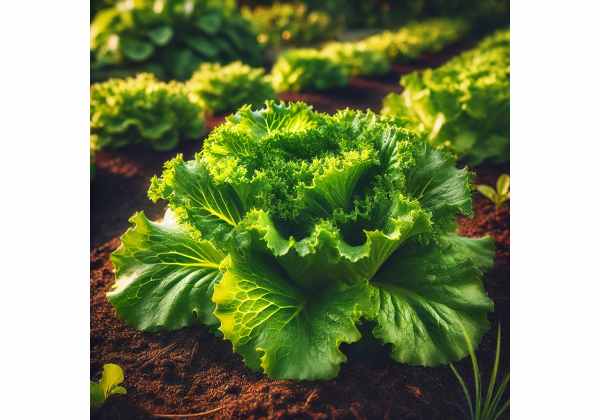
Lettuce, known botanically as Lactuca sativa, is a versatile and widely appreciated leafy green renowned for its crisp texture and subtle flavor. This herb offers an array of benefits, from its nutrient-dense profile to its active compounds like lactucin and lactucopicrin, which contribute to its potential anti-inflammatory and antioxidant properties. Used in culinary delights, traditional remedies, and even cosmetic formulations, lettuce supports heart health and digestive well‐being. Its mild taste and ease of cultivation make it a staple in salads worldwide, while its diverse applications in modern wellness highlight its enduring popularity and health-promoting characteristics.
Table of Contents
- Botanical Characteristics and Identification
- Chemical Makeup and Active Ingredients
- Health Advantages and Core Attributes
- Practical Applications and Safety Guidelines
- Research Insights and Key Findings
- Common Queries about This Herb
Botanical Characteristics and Identification
Lettuce (Lactuca sativa) belongs to the Asteraceae family, sharing its lineage with sunflowers and daisies. This annual plant is cultivated worldwide, thriving in temperate climates with cool, moist conditions. Its taxonomy is well established, and the species is divided into several varieties—including crisphead, romaine, butterhead, and leaf lettuce—each distinguished by unique leaf textures, shapes, and flavors.
In appearance, lettuce displays a spectrum of leaf forms: some are tightly packed and crisp, while others are loosely arranged and tender. The leaves typically vary from bright green to red hues, with subtle differences in size and texture. Under favorable conditions, lettuce produces a central flowering stalk bearing small, yellowish blooms—a natural part of its reproductive cycle that is usually culled in commercial production to preserve leaf quality.
Cultivation practices emphasize soil quality, balanced irrigation, and timely harvesting to prevent bolting (premature flowering) which can compromise taste. Modern agricultural techniques have refined these practices, ensuring that lettuce remains both a fresh salad favorite and a reliable crop for local and commercial markets. Gardeners and commercial growers alike benefit from its relatively short growth cycle, which allows for multiple harvests throughout a season.
The plant’s resilience is underscored by its adaptability to various soil types and climatic conditions. Not only does it serve culinary purposes, but its role in crop rotation schemes helps maintain soil health by minimizing nutrient depletion. Historical records trace lettuce back to ancient Egypt, where it was revered both as food and as a medicinal herb. Today, research continues to explore its bioactive compounds and potential health benefits, linking traditional wisdom with modern science. Detailed morphological studies reveal that the leaves contain a complex matrix of fibers, water, and phytochemicals that contribute to both its refreshing taste and its mild, soothing properties.
Lettuce’s cultivation history has been marked by selective breeding aimed at enhancing desirable traits such as leaf crispness, nutritional content, and resistance to pests. As a result, the modern varieties available in supermarkets and local farms not only offer an appealing aesthetic but also deliver consistent quality. Whether grown in controlled environments or in open fields, lettuce remains a prime example of how traditional horticultural practices intersect with contemporary agricultural science, ensuring its place as a culinary and medicinal staple across cultures and continents.
In summary, the botanical characteristics and identification markers of lettuce make it a remarkable species that is both culturally significant and nutritionally valuable. Its physical attributes—ranging from leaf shape and color to flowering patterns—provide essential clues for identification, while its historical and modern cultivation practices underline its versatility. The plant’s ability to thrive under varying conditions and its adaptability to innovative farming methods further cement its role as a reliable, health-promoting herb with a rich heritage.
From its ancient origins to its modern-day prominence, lettuce continues to captivate both growers and consumers. Its robust yet delicate structure, combined with its multifaceted applications, exemplifies nature’s capacity to offer nourishment and healing in a single, humble leaf. With ongoing research into its bioactive compounds, the future of lettuce as both a dietary staple and a source of natural remedies looks promising and ever-evolving.
Chemical Makeup and Active Ingredients
Lettuce’s health-promoting properties are largely attributed to its diverse chemical profile. Here, we explore a detailed analysis of its active components and beneficial phytochemicals that play a crucial role in its nutritional and medicinal qualities.
- Lactucin
Lactucin is one of the primary sesquiterpene lactones found in lettuce. It contributes to the herb’s characteristic mild bitterness and is noted for its potential sedative and anti-inflammatory effects. Studies suggest that lactucin may interact with neural pathways to promote relaxation, making it a point of interest for research into natural sleep aids and anxiety reduction. - Lactucopicrin
Another important sesquiterpene lactone, lactucopicrin, is known for its slightly more potent bitter flavor compared to lactucin. This compound is associated with analgesic properties and has been studied for its possible role in easing pain and inflammation. Its presence in lettuce underscores the plant’s potential applications in herbal medicine as an adjunct for pain relief. - Flavonoids
Lettuce contains a range of flavonoids, including quercetin and kaempferol. These polyphenolic compounds function as antioxidants, combating oxidative stress by neutralizing free radicals. The protective effect of flavonoids supports cardiovascular health, aids in reducing inflammation, and contributes to overall cellular protection. - Phenolic Compounds
Beyond flavonoids, lettuce harbors various phenolic acids, which are known for their antioxidant activities. These compounds help stabilize cellular membranes and can reduce the risk of chronic diseases by mitigating oxidative damage. Their synergistic effects with other phytochemicals enhance lettuce’s overall health benefits. - Essential Vitamins and Minerals
While not unique to lettuce, its rich assortment of vitamins (such as vitamins A, C, and K) and minerals (including folate, iron, and potassium) plays an integral role in supporting bodily functions. Vitamin K, for instance, is essential for proper blood clotting, while vitamin A supports vision and immune function. These micronutrients add to the herb’s value as a dietary staple, promoting a balanced nutritional profile. - Additional Bioactive Components
Other notable compounds include various carotenoids and chlorophylls that contribute not only to the vibrant color of the leaves but also offer supplementary antioxidant benefits. These compounds may aid in detoxification processes within the body and provide additional protection against environmental stressors.
The interplay between these chemical constituents is a subject of ongoing scientific investigation. Researchers are continually discovering how these bioactive compounds work synergistically to enhance lettuce’s medicinal properties. As a result, lettuce is not only celebrated for its culinary versatility but also for its potential role in promoting health through natural, plant-based compounds.
This comprehensive breakdown of lettuce’s chemical makeup underscores its complex phytochemical landscape. Each component, from lactucin to essential vitamins, contributes uniquely to the herb’s overall profile. The cumulative effect of these compounds supports numerous health benefits, including antioxidant protection, anti-inflammatory action, and potential therapeutic applications. Understanding these active ingredients provides valuable insights into how traditional uses of lettuce are validated by modern scientific research, paving the way for its continued integration into dietary and medicinal practices.
The diverse array of active ingredients in lettuce exemplifies nature’s intricate design, where even a seemingly simple leafy vegetable contains a wealth of compounds beneficial for human health. With each phytochemical playing a distinct role, lettuce stands out as a potent source of natural health-enhancing elements, reinforcing its status as a valued herb in both culinary and medicinal domains.
Health Advantages and Core Attributes
Lettuce is celebrated not only for its crisp, refreshing taste but also for its impressive array of health benefits. This section delves into the nutritional strengths and core attributes that make lettuce a favored choice for health-conscious individuals around the globe.
One of the primary advantages of lettuce is its low-calorie, high-fiber profile, making it an ideal component of weight management and digestive health regimes. Its abundant water content aids in hydration and contributes to a feeling of fullness, thereby supporting healthy eating habits. The presence of dietary fiber in lettuce helps regulate bowel movements and fosters a healthy gut microbiome, which is essential for overall digestive wellness.
Rich in antioxidants such as flavonoids and phenolic compounds, lettuce plays a significant role in neutralizing harmful free radicals. These antioxidants help reduce oxidative stress, which is linked to the development of chronic diseases, including cardiovascular disorders and certain types of cancer. By mitigating cellular damage, lettuce supports long-term health and vitality.
Moreover, the essential vitamins found in lettuce—particularly vitamins A, C, and K—are critical for various bodily functions. Vitamin A is vital for maintaining healthy vision and immune response, while vitamin C enhances the absorption of iron and bolsters immune defenses. Vitamin K is instrumental in blood clotting and bone health, underscoring lettuce’s role in maintaining skeletal integrity.
Lettuce also contains minerals such as potassium and folate. Potassium helps regulate blood pressure and supports heart function, whereas folate is important for cell growth and regeneration. These micronutrients work in concert to promote cardiovascular health and support overall metabolic processes.
In addition to its nutritional content, lettuce has been traditionally used in natural remedies for its mild sedative and anti-inflammatory properties. The presence of compounds like lactucin and lactucopicrin may contribute to relaxation and pain relief, thereby offering a complementary approach to managing stress and discomfort. These healing properties of lettuce are increasingly recognized in both folk medicine and modern nutritional research.
Furthermore, the versatility of lettuce allows it to be easily incorporated into a variety of diets. Whether consumed raw in salads, blended into smoothies, or lightly steamed as a side dish, its adaptable nature makes it accessible to people of all ages. This ease of use, combined with its nutritional benefits, positions lettuce as a key ingredient in promoting balanced diets and healthy lifestyles.
Ultimately, the health advantages of lettuce extend far beyond its culinary appeal. Its robust nutritional profile and the synergistic effects of its active compounds contribute to a multitude of health benefits, ranging from improved digestion and immune function to cardiovascular support and potential anti-inflammatory effects. As scientific research continues to explore these benefits, lettuce remains at the forefront of both dietary innovation and natural health promotion.
Practical Applications and Safety Guidelines
The versatility of lettuce is evident in its myriad applications across culinary, medicinal, and cosmetic realms. This section provides an in-depth look at the various ways lettuce is used, along with practical guidelines to ensure its safe and effective incorporation into daily routines.
Culinary Uses
Lettuce is a cornerstone of the culinary world. Its crisp texture and mild flavor make it a perfect base for salads, sandwiches, wraps, and garnishes. Chefs around the globe use different varieties—such as romaine for its crunchy texture, butterhead for its tender leaves, and leaf lettuce for its versatility—to create visually appealing and nutrient-rich dishes. Incorporating lettuce into meals not only enhances flavor but also boosts nutritional content, making it a popular choice for those seeking both taste and health benefits.
Medicinal Applications
Beyond the plate, lettuce has been traditionally employed as a natural remedy. The herb’s cooling properties and bioactive compounds, including lactucin and lactucopicrin, have been linked to potential sedative and anti-inflammatory effects. In folk medicine, lettuce infusions and extracts have been used to alleviate mild anxiety, promote sleep, and ease digestive discomfort. While these traditional uses are promising, individuals interested in exploring the medicinal uses of lettuce should consult healthcare professionals to determine appropriate usage and dosage.
Cosmetic and Topical Uses
Lettuce extracts are increasingly finding their way into cosmetic formulations. Rich in antioxidants and hydrating compounds, these extracts can be used in skincare products to soothe irritated skin and provide a natural, refreshing effect. When used in face masks and creams, lettuce contributes to the maintenance of healthy skin by supporting cellular repair and offering a mild anti-inflammatory benefit.
Preparation Methods and Dosage Recommendations
When incorporating lettuce into your diet or health regimen, proper preparation is key. For culinary purposes, washing the leaves thoroughly and using them fresh ensures that you receive the maximum nutritional benefits. For medicinal applications, cold-pressed extracts or gentle infusions are recommended to preserve the delicate bioactive compounds. Although lettuce is generally safe for most individuals, moderation is advised. Excessive consumption, especially of certain varieties, may lead to digestive discomfort in sensitive individuals.
Safety Considerations
While lettuce is widely regarded as safe, a few precautions should be observed. Individuals with specific allergies or sensitivities should perform a patch test before using lettuce-based cosmetic products. Furthermore, those on blood-thinning medications must monitor their vitamin K intake, as lettuce is a natural source of this nutrient. As with any herb, potential interactions with medications or other supplements warrant consultation with a healthcare provider.
Overall, the practical applications of lettuce are as diverse as its benefits. From enhancing daily meals to serving as a complementary remedy, its uses span multiple disciplines. By following proper preparation techniques and adhering to recommended dosages, users can safely enjoy the full spectrum of lettuce’s benefits. Embracing the healing properties of lettuce, whether for its culinary charm or its medicinal promise, allows for a holistic approach to health that integrates natural, time-tested practices with modern nutritional wisdom.
Research Insights and Key Findings
Recent scientific investigations have shed light on the diverse benefits and applications of lettuce, validating many traditional claims through rigorous studies. Below is a numbered list summarizing some significant research findings related to this herb:
- Study on Antioxidant Activity (2018)
Published in the Journal of Agricultural and Food Chemistry, this study examined the antioxidant capacity of various lettuce cultivars. The findings indicated that the high levels of flavonoids and phenolic compounds in lettuce contribute significantly to its free-radical scavenging activity, suggesting potential benefits for reducing oxidative stress. - Investigation into Anti-Inflammatory Effects (2019)
Researchers explored the anti-inflammatory properties of lettuce extracts in a controlled laboratory setting. The study, appearing in Phytotherapy Research, demonstrated that compounds such as lactucin and lactucopicrin effectively reduced markers of inflammation in cell cultures, supporting the herb’s traditional use as a mild sedative and pain reliever. - Nutritional Profile and Health Benefits (2020)
A comprehensive analysis published in Nutrients detailed the impressive nutritional profile of lettuce, highlighting its role in supporting cardiovascular health and aiding digestion. The study emphasized the benefits of dietary fiber and essential vitamins in maintaining overall health, while also exploring lettuce’s potential in weight management strategies. - Impact on Gut Microbiota (2021)
A groundbreaking study featured in Food Research International examined how regular consumption of lettuce affects the gut microbiome. The research found that the prebiotic fibers in lettuce promote a healthy balance of gut bacteria, which is crucial for improving digestive health and bolstering the immune system. - Clinical Evaluation of Lettuce Extracts (2022)
Recent clinical trials have begun to evaluate the efficacy of lettuce extracts as a complementary treatment for mild insomnia and anxiety. Early results published in Complementary Therapies in Medicine suggest that lettuce-based formulations may help improve sleep quality and reduce stress, although further studies are needed to establish standardized dosages and long-term safety.
These research insights not only confirm many of the traditional uses of lettuce but also pave the way for future studies to explore its full therapeutic potential. The integration of modern scientific methods with age-old practices continues to reveal new dimensions of this common yet extraordinary herb.
Common Queries about This Herb
What are the primary nutritional benefits of lettuce?
Lettuce offers a low-calorie, high-fiber profile along with essential vitamins and minerals such as vitamins A, C, and K, potassium, and folate. These nutrients support digestion, immune function, and cardiovascular health, making it a valuable addition to any balanced diet.
Can lettuce be used for medicinal purposes?
Yes, lettuce has been traditionally used to promote relaxation and alleviate mild pain and inflammation due to its active compounds like lactucin and lactucopicrin. However, while promising, these medicinal uses should be approached cautiously and discussed with a healthcare professional before use.
How does lettuce contribute to heart health?
Lettuce supports cardiovascular health by providing essential vitamins and minerals, including potassium which helps regulate blood pressure. Additionally, its antioxidant compounds reduce oxidative stress and inflammation, thereby contributing to a healthier heart and overall vascular function.
Is it safe to use lettuce extracts in skincare products?
Lettuce extracts are generally considered safe in cosmetic applications due to their hydrating and anti-inflammatory properties. However, individuals with sensitive skin should conduct a patch test first and consult with a dermatologist if they have any concerns about potential allergic reactions.
How can I incorporate lettuce into my daily meals?
Lettuce can be enjoyed in a variety of ways—from fresh salads and wraps to smoothies and lightly steamed dishes. Its versatility makes it easy to incorporate into daily meals, ensuring that you benefit from its nutritional profile while enjoying its crisp texture and refreshing flavor.
Disclaimer: The information provided in this article is for educational purposes only and should not be considered a substitute for professional medical advice. Always consult with a healthcare professional before making any changes to your diet or health regimen.
If you found this article helpful, please share it on Facebook, X (formerly Twitter), or your favorite social media platform. Follow us on social networks for more engaging and informative content!










